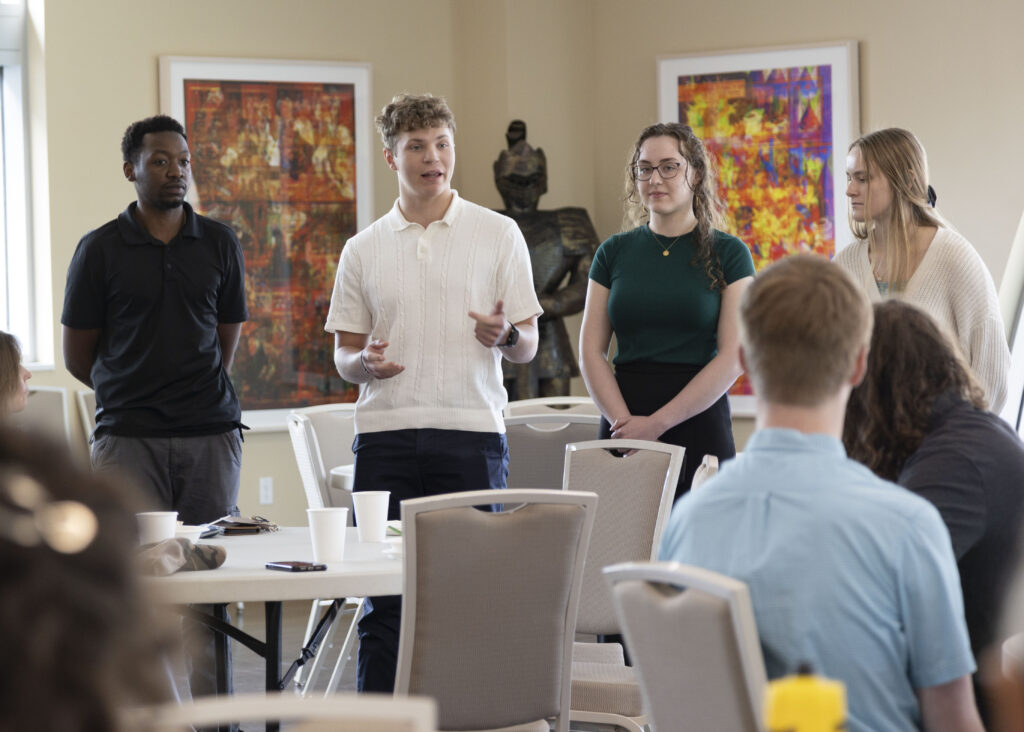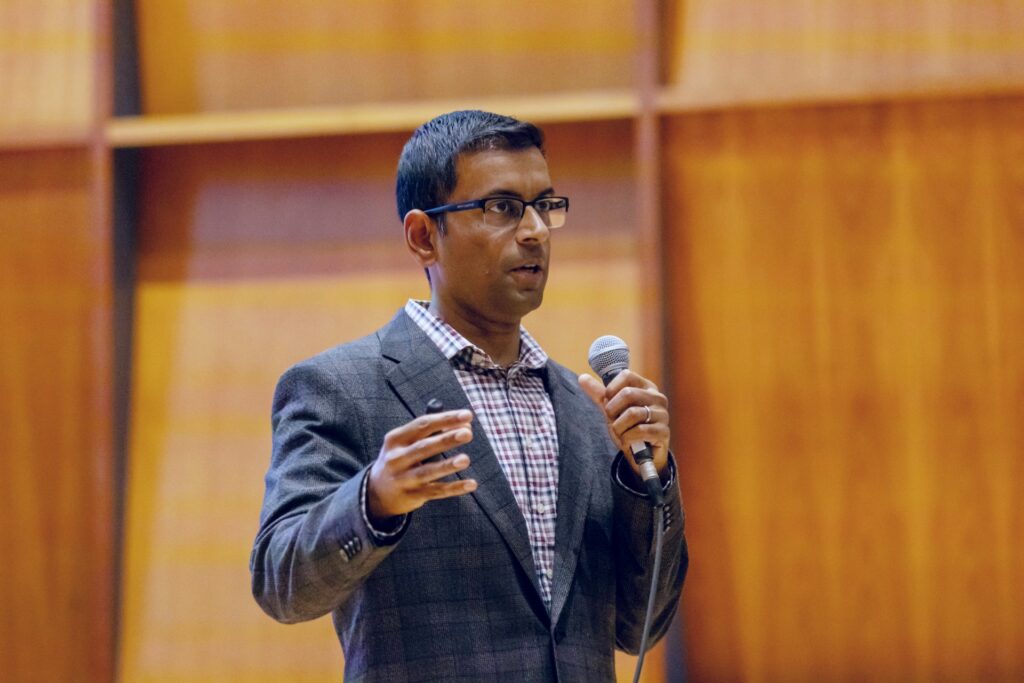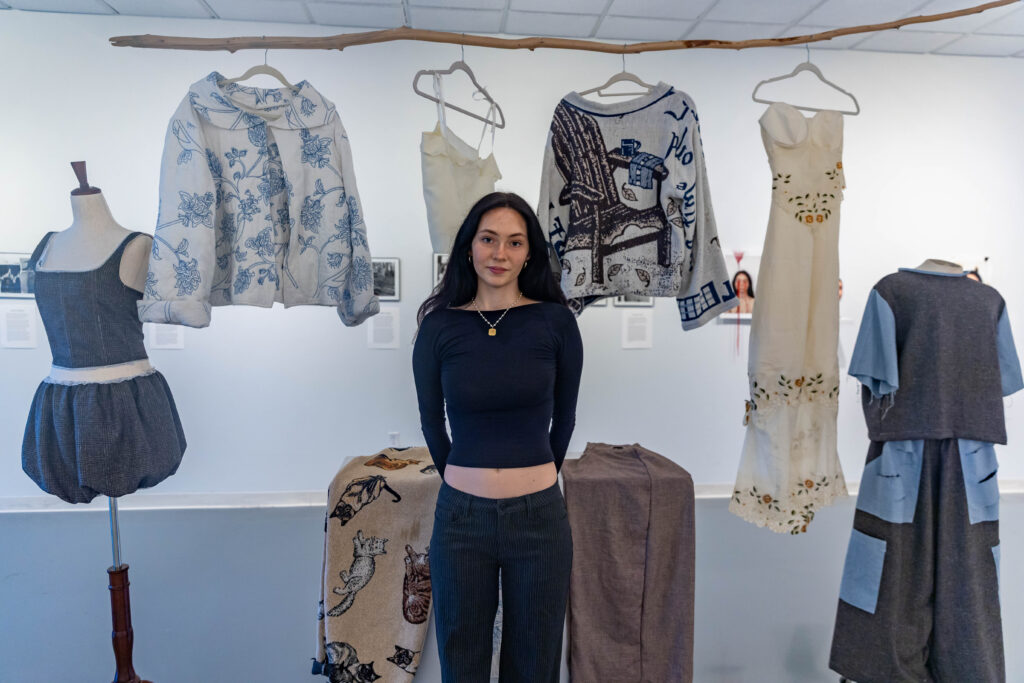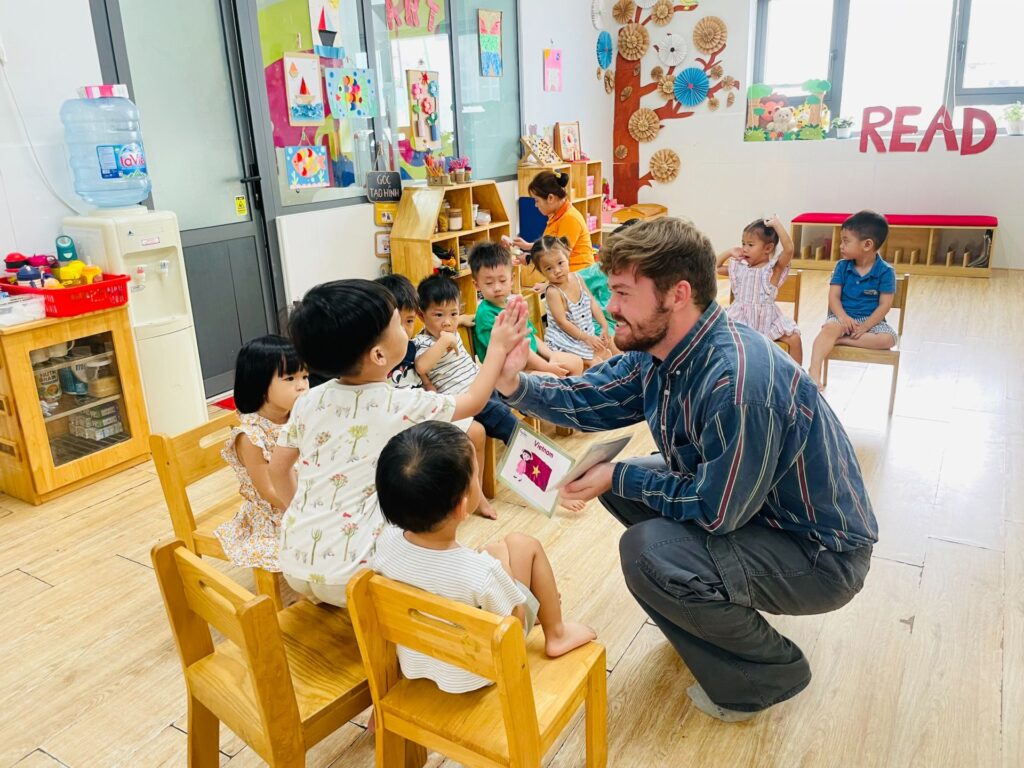Summer research at Saint Michael’s College officially kicked off with a breakfast and short presentations by students who will be investigating a myriad of topics throughout June and July.
The breakfast, held on June 4, provided a chance for students to share their research concepts and hypotheses, as well as what they hope to accomplish over the next two months. Many of the researchers were awarded grants through the College’s Academic Affairs office, while others have been funded by the College’s Leahy Institute for the Environment or grants obtained from organizations outside the College.
This group of students and faculty will reconvene in late July to present their current findings and reflect on their experiences. Each student is also expected to write a brief report about their research and deliver a formal presentation during the upcoming academic year.

Saint Michael’s College President Richard Plumb speaks to student researchers and their faculty mentors during a research kickoff breakfast on June 4, 2025. (Photo by Elizabeth Murray)
Vice President for Academic Affairs and Provost Gretchen Galbraith provided opening remarks at the breakfast, congratulating all the students selected to complete summer research, as it was a very competitive process.
Dr. Richard Plumb, President of Saint Michael’s College, also offered his advice to the researchers, saying, “Be curious, keep your mind open, and allow yourself to be surprised.”
Plumb reminded students that while they have selected an area of study and a hypothesis at the moment, their hypothesis can – and likely will – change upon conducting research.
Below is a list of the research projects being conducted on campus this summer.

Student researcher Carl Barton ’27 explains the premise of his summer research project at the kickoff breakfast on June 4, 2025. His faculty mentor, Professor Stephon Boatwright, left, looks on. (Photo by Elizabeth Murray)
How the media portrays crime
Student researcher: Carl Barton ’27
Faculty mentor: Stephon Boatwright, Political Science and International Relations Department
Barton will be exploring how the representation of crime by various media such as broadcast news, social media platforms, television, and film, influence public perception of crime rates. Barton is basing his research on George Gerbner’s “cultivation theory,” which states that prolonged exposure to television viewing shapes people’s perceptions of reality. Gerbner also proposed that those who view television in higher amounts are more influenced by media content, resulting in a distorted view of reality. Barton will use this theory in his research to understand how crime is portrayed in the media and if it actually influences public perception of safety and crime rates. He hopes this information can then be used to understand if these beliefs impact public policies.
Art as advocacy
Student researcher: Callie Boisvert ’27
Faculty mentor: Jordan Douglas, Fine Arts: Art and Design Department
Boisvert will research the role of art as a form of advocacy. She will conduct and analyze interviews with artists local to Saint Michael’s to explore how they are working to promote social change through their art. Boisvert will also use film photography alongside her interviews, developing images in the Sloane Hall darkroom. Upon completing her project, Boisvert will frame and display her images alongside her research in the McCarthy Art Gallery. She hopes to highlight the power of art in advancing social justice and change through her research and presentation.
Continued Alzheimer’s research
Student researchers: Michael Braennare-Gran ’27, Kaiza Kipingi ’26, Lydia Kragh ’27, and Abigail Whitley ’26
Faculty mentor: Ruth Fabian-Fine, Neuroscience and Biology departments
Braennare-Gran, Kipingi, Kragh and Whitley will all be working with Fabian-Fine to conduct research surrounding the underlying causes of Alzheimer’s disease. Recently, researchers at Saint Michael’s College made an important discovery: a glial canal system in the brain’s hippocampus (a part of the brain involved in memory) that may help remove waste from brain cells. Previous studies on Alzheimer’s Disease have suggested that possible damage to this waste removal system may cause brain cells to die, furthering the impact of the disease. The students will work to determine if the waste canal systems in the brain are effectively clearing out harmful proteins or not. They will work with a technique called colloidal gold, as well as using immunohistochemical methods and gene expression to investigate proteins that contribute to the process that governs the waste removal system.

From left, student researchers Kaiza Kipingi ’26, Michael Braennare-Gran ’27, Lydia Kragh ’27, and Abigail Whitley ’26 explain the research they will continue to push forward on Alzheimer’s disease with the mentorship of Neuroscience Professor Ruth Fabian-Fine. (Photo by Elizabeth Murray)
‘Slow fashion’ and sustainability
Student researcher: Chloe Brown ’27
Faculty mentor: Jordan Douglas, Fine Arts: Art and Design Department
Brown’s interest in art and clothing is driving her research into the fast fashion industry and its impact on climate change. Through her research, Brown will create clothing that aims to be both fashion-forward and environmentally responsible. Brown also plans to create clothing that is inclusive of different body types. She will focus her skills in art, design, and sustainable practices on designing patterns for her clothing pieces, sourcing eco-friendly textiles from local second-hand stores and fabric recycling programs. To further avoid contributing to textile waste, Brown will prioritize durability and versatility in her clothing, ensuring it can be worn for years to come. Her completed research and clothing pieces will be showcased in the McCarthy Arts Center.
Are young men more conservative?
Student researcher: Meg Clements ’26
Faculty mentor: Trish Siplon, Political Science and Public Health departments
Clements will spend her summer researching whether men within the age group of 18-27 have become more conservative and, if so, why this may be. To conduct this research, Clements will look at the social and political forces that may be driving this change. This research topic was inspired by the 14-point margin of men from the ages of 18-29 who voted for President Donald Trump, the Republican candidate, over Kamala Harris, the Democratic candidate in the national election in 2024. If Clements is able to prove her hypothesis correct, she will move to examining social media changes and trends, schooling patterns, and differences in recent social lives that may have resulted in this shift among men within the last decade.
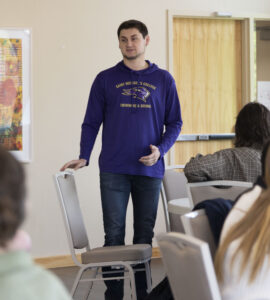
Student researcher Hunter Daily ’27 speaks about his research involving measuring the level of pollutants in the soil of the Winooski River. (Photo by Elizabeth Murray)
Looking at pollutant levels in the Winooski River’s soil
Student researcher: Hunter Daily ’27
Faculty mentor: Shane Lamos, Chemistry Department
This summer, Daily will continue a research project started by a group of previous undergraduate students at Saint Michael’s College that aims to measure the level of pollutants in the Winooski River. The river that stretches across much of northern Vermont has been exposed for years to harmful metals and chemicals in its waterways. These materials have continued to have negative effects on the health of the river.
Through his research, Daily will collect samples of soil from various areas along the riverbanks to measure the long-term concentration of pollutants. He hopes this will be a valuable resource, not only for Saint Michael’s students, but also for use by the public, environmental groups, and future surveys.
Analyzing heavy metals at the Pike Hill Mine Superfund site
Student researcher: Sean DeVito ’27
Faculty mentor: Shane Lamos, Chemistry Department
DeVito will collect and analyze soil and water samples from the Pike Hill Mine located in Corinth, Vermont, to assess its contamination levels. The Pike Hill Mine was shut down in the early 1900s, and in 2004, it was named an EPA Superfund site. Despite this designation, the site continues to release harmful pollutants into nearby waterways. DeVito will use these water and soil samples to better understand the severity of the contamination and the resulting environmental impact.
Measuring medicinal effects of phytocannabinoid derivatives
Student researcher: Jacob Gaudet ’26
Faculty mentor: Mark Scialdone, Chemistry Department
This summer, Gaudet will conduct research to synthesize a new medicine from a compound called HHCA, which is a laboratory-made compound identical to Delta 9-THCA (the primary psychoactive compound in cannabis). This medicine will be used to treat conditions including pain, inflammation, and even more serious diseases, such as Alzheimer’s, he said. Gaudet will test these new versions of HHCA, with help from the Biology Department, to see if it connects receptors that control pain, mood, and even the immune system in the body. The goal of this research is to make a new version of this medicine that will enhance its medicinal effects and prolong the amount of time the medicine works in the body. This research done by Gaudet could lead to major breakthroughs, allowing scientists to create better-equipped medical treatments.

Student researcher Olivia Goldfarb ’27 speaks about the research she will be conducting with lab partner Gavin Graham ’26 into the genetic disease X-MAID (X-Linked Moesin-Associated Immunodeficiency). (Photo by Elizabeth Murray)
Working to understand the genetic disease X-MAID
Student researchers: Olivia Goldfarb ’27 and Gavin Graham ’26
Faculty mentor: Lyndsay Avery, Biology Department
X-Linked Moesin-Associated Immunodeficiency (X-MAID) is a genetic disease that primarily affects T cells and their migration. Goldfarb will research how X-MAID affects T cells, which are very important to the body’s immune system. The goal of Goldfarb’s research is to better understand how these T cells grow and make copies of themselves. She will complete this process by using a special dye that gets lighter each time a cell divides, allowing Goldfarb to monitor how fast the T cells are multiplying. This information will be used to compare T cells with the X-MAID mutation and those without using a machine known as a flow cytometer. This information can help explain how the genetic disease impacts the immune system and can then be used for more advanced treatments of immune disorders
X-MAID is caused by a small mutation called R171W in a protein known as moesin. This mutation stops the moesin from being able to attach to the cytoskeleton and cell membrane, the parts of the cell that help keep its shape and move. Due to this inability, the T cells have trouble changing shape, an asset that is needed in order to migrate properly. Graham will study how this mutation impacts moesin’s interactions with other proteins. He will do so using techniques like immunoprecipitation, gel electrophoresis, and mass spectrometry. These processes will help Graham better understand why the T cell movement and migration is impaired in X-MAID.
Exploring fear through photography and digital art
Student researcher: Abigail Gyurko ’27
Faculty mentor: Rebecca Gurney, Fine Arts: Art and Design Department
Inspired by the Dada and Surrealist art movements, Gyurko will study surrealist photography and the art of digital collages. Gyurko will create art that is directly intertwined with her personal fears. She plans to use a variety of models for her photos and will then transform the images into digital art through software such as Adobe Photoshop to visualize fear. This work will combine historical art influences like Dada with modern technological techniques. Gyurko’s final pieces will be displayed in the McCarthy Art Gallery.
Classroom management in a post-COVID world
Student researcher: Aidan Hall ’27
Faculty mentor: Karen Popovich, Business Administration and Accounting Department
Hall will study how feedback loops, or continuous back-and-forth communication between teachers and students, can improve both teaching and learning in the post-COVID-19 world. He will conduct focus groups and classroom observations to better understand how physical space, lessons, and assessments can be used to better teach Generation Alpha. The goal of this study is to encourage student engagement with their educators and, as a result, improve teaching methods. A better learning environment for students can help to eliminate distractions and improve overall outcomes, he hypothesizes.
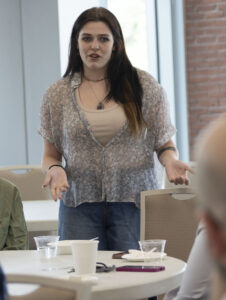
Bethany Hayes ’27 explains her summer research project which involves developing quality control testing for saffron. (Photo by Elizabeth Murray)
Quality control testing for saffron
Student researcher: Bethany Hayes ’27
Faculty mentor: Shane Lamos, Chemistry Department
Saffron is the world’s most expensive spice, often sold for $60 to $80 per gram. This large price point has often led sellers to add impurities to their product to “bulk it up” for a profit. However, unlike many other spices, saffron does not currently have a quality testing standard.
This summer, Hayes will study and develop a reliable testing method for the quality of saffron using Nuclear Magnetic Resonance (NMR). This information and testing method can then be used to improve saffron purity in the greater marketplace. She is also partnering with the Farm on Saint Michael’s campus, which is growing saffron.
Producing pCAP for research, safely and sustainably
Student researcher: Emily Huebel ’26
Faculty mentor: Megan Browning, Chemistry Department
Huebel’s research this summer will focus on creating a safer, more environmentally conscious, and efficient way to produce pCAP, a tool that is used to study PTPs (protein tyrosine phosphatase). PTPs are proteins responsible for cell growth, immune response, and diseases within the body. When the PTPs are active, pCAP will light up, helping researchers study them in live cells. However, the current method to make pCAP uses various toxic chemicals and produces lots of waste, she said. Huebel’s goal is to develop a cleaner and more sustainable process to create pCAP, which can be used in the future for larger-scale research and future drug development.
Ensuring purity in off-market antiviral drugs for cats
Student researcher: Isabella Joly ’26
Faculty mentor: Megan Browning, Chemistry Department
Feline infectious peritonitis (FIP) is a deadly disease caused by feline coronavirus with a 100% fatality rate. There have been recent developments of antiviral drugs to treat FIP in cats, but because these drugs are very expensive and not fully FDA approved, many pet owners are either unable to access the drugs or are forced to buy them from unregulated markets. This summer, Joly will research these off-market drugs to differentiate their purity and inconsistencies, as well as compare medicines in both solid and liquid forms. The goal of this research is to provide advanced information about these drugs with the potential to advance veterinary access and care.

Student researcher Evan Kennedy ’26 explains their project exploring queer identity, culture and media through art during the summer research kickoff breakfast on June 4, 2025. (Photo by Elizabeth Murray)
Examining queerness through art
Student researcher: Evan Kennedy ’26
Faculty mentor: Mallory Breiner, Fine Arts: Art and Design Department
Kennedy will use their interest in art to explore queer identity, culture and media through traditional 2-D art. They will use various techniques, including oil painting, linocut printmaking, and drawing to bring their work to life. The goal of their research is not only to inspire personal growth, but also to contribute to the ongoing conversation about the importance of queer art. Kennedy will be creating a collection of art pieces that will be displayed in the McCarthy Art Gallery.
Improving the analysis of phytocannabinoids
Student researcher: Hannah Kragh ’26
Faculty mentor: Mark Scialdone, Chemistry Department
Kragh’s research this summer aims to improve how scientists analyze phytocannabinoids, which are naturally occurring cannabinoids found in the Cannabis sativa plant and can have potential pharmaceutical benefits. Kragh’s research will focus on developing a more accurate and efficient method by using high-performance liquid chromatography (HPLC) and a Shimadzu LCMS instrument. Kragh’s work toward refining this technique will contribute to future phytocannabinoid research, as well as enhancing methods used in pharmaceutical and natural product chemistry. Her research will not only provide information to a growing field but will also provide Kragh with valuable experience in analytical chemistry.
Examining Islam in France
Student researcher: Ava Lavigne ’26
Faculty mentor: James Byrne, Religious Studies Department
This summer, Lavigne will research and explore the interaction between Islam and laïcité, or French secularism,in modern-day France. While the country itself is officially secular and does not follow any particular religion closely, many immigrants from former Muslim-majority French colonies are moving to France, Lavigne said. This migration has led to growing tension between people practicing religion and the country’s policies, which has resulted in conflict or controversy in the past. Lavigne’s research project aims to better understand the complexity of this relationship and highlight this issue that has often been overlooked in public discussions. She will also incorporate experiences from her summer interning in Paris last year.

Student researcher Ava Lavigne ’26 explains her research into Islam in France during the summer research kickoff breakfast on June 4, 2025. (Photo by Elizabeth Murray)
Modern transgender portraiture
Student researcher: Eden Milczanowski ’27
Faculty mentor: Rebecca Gurney, Fine Arts: Art and Design Department
Milczanowski will use portrait art to explore and celebrate the transgender experience. Their work is inspired by fellow artists such as Amy Sherald, Kehinde Wiley, and Rae Senarighi. Milczanowski’s final project will aim to include at least six portraits of different transgender individuals, all at different stages in their transitions. Milczanowski, who is transgender, hopes to challenge stereotypes and highlight diversity within the community through their artwork.
How coverage and bias shape reporting and public perception
Student researcher: Olivia Miller-Johnson ’26
Faculty mentor: Sebastiaan Gorissen, Digital Marketing Department
This summer, Miller-Johnson will examine how major U.S. news outlets covered recent changes to content moderation on Meta apps, including Instagram and Facebook. Miller-Johnson will include the removal of fact-checkers in her research. The aim of her research project is to examine how each news outlet’s political bias may have influenced their coverage and reporting. Miller-Johnson will also be researching how this coverage and bias shape public perception and influence societal division. By analyzing these differences among different news outlets, she hopes to explore larger questions about echo chambers and the possibility of moving beyond growing polarization.
Using algae and diatoms to help clean polluted lakes
Student researcher: Shannah Weller ’27
Faculty mentor: Clayton Williams, Environmental Studies and Science Department
Weller will research how algae and diatoms, small organisms living in bodies of water, can help clean polluted lakes. In order to conduct this research, Weller will take water samples from six different lakes with varying pollutant levels to analyze how the natural algae and diatoms respond to the pollution. For example, Weller will conduct one experiment that involves taking algae from one lake and placing it in water from a different lake to see if it can remove pollutants like nitrogen and phosphorus. Weller’s research will also involve using plastic bio-balls to grow algae and moving these balls to a new water sample to test their cleaning power. The overall goal of their experiments and research is to see if these organisms can naturally improve water quality.
COVID-19 in Vermont
Student researcher: Benjamin Wilson ’26
Faculty mentor: Bradford Demarest, Computer Science Department
From the early stages of the COVID-19 pandemic, Vermont stood out in the U.S. as the state with the lowest new cases as the pandemic progressed, Wilson said. Wilson will be researching why and how Vermont managed the COVID-19 pandemic more effectively than most states in the country. He will focus his research on understanding what makes Vermont different from other states and how it shaped the state’s response to the global pandemic. To conduct this research, Wilson will use machine learning models and word analysis techniques to study the language used in Vermont Governor Phil Scott’s COVID-19 press conferences. The goal of Wilson’s research is to better understand what characteristics, such as Vermont’s unique sense of community, influenced the state’s success in keeping new cases low during the pandemic.

For all press inquiries contact Elizabeth Murray, Associate Director of Communications at Saint Michael's College.
